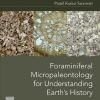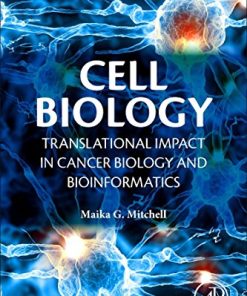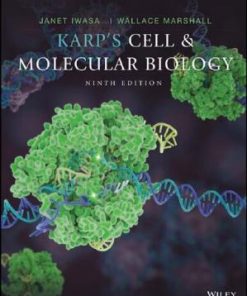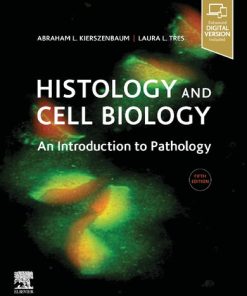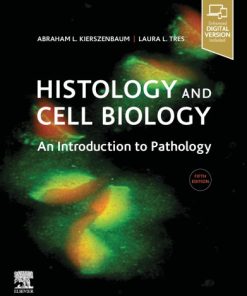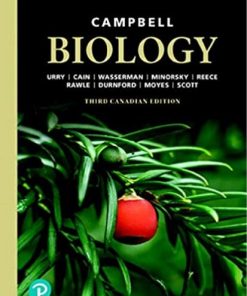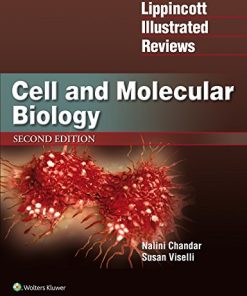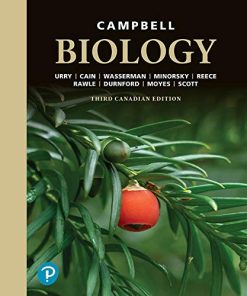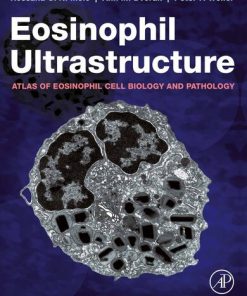(Ebook PDF) Cell biology 3rd Edition by Thomas Pollard, William Earnshaw, Jennifer Lippincott Schwartz, Graham Johnson 0323399983 9780323399982 full chapters
$50.00 Original price was: $50.00.$25.00Current price is: $25.00.
Cell biology 3rd Edition by Thomas D. Pollard, William C. Earnshaw, Jennifer Lippincott Schwartz ,Graham Johnson – Ebook PDF Instant Download/DeliveryISBN: 0323399983, 9780323399982
Full download Cell biology 3rd Edition after payment.
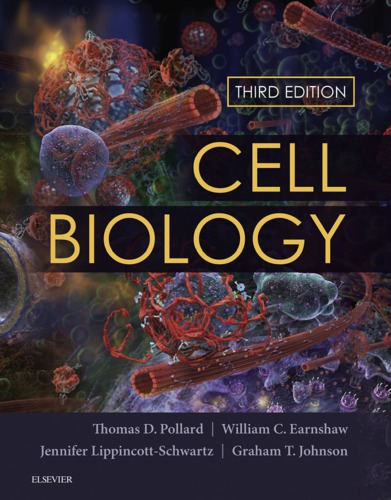
Product details:
ISBN-10 : 0323399983
ISBN-13 : 9780323399982
Author: Thomas D. Pollard, William C. Earnshaw, Jennifer Lippincott Schwartz ,Graham Johnson
The much-anticipated 3rd edition of Cell Biology delivers comprehensive, clearly written, and richly illustrated content to today’s students, all in a user-friendly format. Relevant to both research and clinical practice, this rich resource covers key principles of cellular function and uses them to explain how molecular defects lead to cellular dysfunction and cause human disease. Concise text and visually amazing graphics simplify complex information and help readers make the most of their study time.
Cell biology 3rd Table of contents:
Section I Introduction to Cell Biology
Chapter 1 Introduction to Cells
Universal Principles of Living Cells
Features That Distinguish Eukaryotic and Prokaryotic Cells
Overview of Eukaryotic Cellular Organization and Functions
Welcome to the Rest of the Book
Chapter 2 Evolution of Life on Earth
Prebiotic Chemistry Leading to an RNA World
Divergent Evolution From the Last Universal Common Ancestor of Life
Evolution of Prokaryotes
Origin of Eukaryotes
The First Billion Years of Eukaryotic Evolution
Divergence Eukaryotes From Last Eukaryotic Common Ancestor
Evolution of Multicellular Eukaryotes
Looking Back in Time
Acknowledgments
Selected Readings
Section II Chemical and Physical Background
Section II Overview
Chapter 3 Molecules
Water
Proteins
Nucleic Acids
Carbohydrates
Aqueous Phase of Cytoplasm
Acknowledgments
Selected Readings
Chapter 4 Biophysical Principles
First-Order Reactions
Second-Order Reactions
Reversible Reactions
Thermodynamic Considerations
Linked Reactions
Chemical Bonds
Strategy for Understanding Cellular Functions
Analysis of an Enzyme Mechanism: The Ras GTPase
Acknowledgment
Selected Readings
Chapter 5 Macromolecular Assembly
Assembly of Macromolecular Structures From Subunits
Specificity by Multiple Weak Bonds on Complementary Surfaces
Symmetrical Structures Constructed From Identical Subunits
Assembly Pathways
Regulation at Multiple Steps on Sequential Assembly Pathways
Acknowledgment
Selected Readings
Chapter 6 Research Strategies
Imaging
Light Microscopy Methods
Fluorescence Microscopy
Electron Microscopy
Choice of Organisms for Biological Research
Inventory: Gene and Protein Discovery
Genome Engineering
Molecular Structure
Partners and Pathways
Rates and Affinities
Reconstitution of Function From Isolated Components
Anatomic Tests of Physiological Function
Three Options to Test for Physiological Function
Mathematical Models of Systems
Selected Readings
Section III Chromatin, Chromosomes, and the Cell Nucleus
Section III Overview
Chapter 7 Chromosome Organization
Chromosome Morphology and Nomenclature
One DNA Molecule Per Chromosome
Organization of Genes on Chromosomes
Transposable Elements Make up Much of the Human Genome
Pseudogenes
Segmental Duplications in the Human Genome
The Human Genome: Variations on a Theme
The Centromere: Overview
Ends of the Chromosomes: Why Specialized Telomeres Are Needed
Acknowledgments
Selected Readings
Chapter 8 DNA Packaging in Chromatin and Chromosomes
First Level of Chromosomal DNA Packaging: The Nucleosome
Functional Compartmentation of Chromatin: Heterochromatin and Euchromatin
Higher-Order Structure of Chromosomes
Large-Scale Structural Compartmentation of the Nucleus
Chromatin Conformation Capture and Topologically Associating Domains
The Chromosome’s Control Center: The Kinetochore
Mammalian Kinetochore Proteins
Centromere Proteins of the Budding Yeast
Role of RNA Interference at Fission Yeast Centromeres
Conclusions
Acknowledgments
Selected Readings
Chapter 9 Nuclear Structure and Dynamics
Overall Organization of the Nucleus
Structure of the Nuclear Envelope
Traffic Between Nucleus and Cytoplasm
Disorders Associated With Defective Nuclear Trafficking
Other Uses of the Importin/Ran Switch
Acknowledgments
Selected Readings
Section IV Central Dogma: From Gene to Protein
Section IV Overview
Chapter 10 Gene Expression*
Transcription Cycle
Transcription Initiation
Transcription Elongation and Termination
Gene-Specific Transcription Regulation
Chromatin and Transcription
Transcription Factors and Signal Transduction
Selected Readings
Chapter 11 Eukaryotic RNA Processing*
Synthesis of Messenger RNAs
Modification of Messenger RNAs
Synthesis of Stable RNAs
Synthesis and Function of Micro-RNAs
Synthesis and Function of Piwi-Interacting RNAs
Synthesis and Function of Other Noncoding RNAs
RNA-Based Gene Editing
Conclusions
Selected Readings
Chapter 12 Protein Synthesis and Folding*
Protein Synthetic Machinery
Mechanism of Protein Synthesis
Spontaneous Protein Folding
Chaperone-Assisted Protein Folding
Acknowledgment
Selected Readings
Section V Membrane Structure and Function
Section V Overview
Chapter 13 Membrane Structure and Dynamics
Development of Ideas About Membrane Structure
Lipids
Physical Structure of the Fluid Membrane Bilayer
Membrane Proteins
Acknowledgments
Selected Readings
Chapter 14 Membrane Pumps
Introduction to Membrane Permeability
Diversity of Membrane Pumps
Light-Driven Proton Pumping by Bacteriorhodopsin
Overview of Adenosine Triphosphate–Driven Pumps
Rotary ATPase Families
P-Type Cation Pumps: E1E2-Adenosine Triphosphatases
Adenosine Triphosphate–Binding Cassette Transporters
Acknowledgments
Selected Readings
Chapter 15 Membrane Carriers
Basic Carrier Mechanism
Three Transport Strategies
Diversity of Carrier Proteins
Acknowledgments
Selected Readings
Chapter 16 Membrane Channels
Channel Diversity and Evolution
Channel Structure
Channel Activity
Channels With One Transmembrane Segment
Channels With Two Transmembrane Segments
S5-S6 Channel Family
Ion Channels Gated by Extracellular Ligands
Chloride Channels
Ammonia Channels
Water Channels
Porins
Other Families of Channels
Acknowledgments
Selected Readings
APPENDIX 16.1 Examples of Channel-Blocking Agents
APPENDIX 16.2 Electrical Recordings in Biology
APPENDIX 16.3 Biophysical Basis of Membrane Potentials
APPENDIX 16.4 Charging and Discharging the Membrane
Chapter 17 Membrane Physiology
Chemiosmotic Cycles
Epithelial Transport
Cellular Volume Regulation
Excitable Membranes
Synaptic Transmission
Acknowledgments
Selected Readings
Section VI Cellular Organelles and Membrane Trafficking
Section VI Overview
Chapter 18 Posttranslational Targeting of Proteins
Transport of Proteins Into Mitochondria
Transport of Proteins Into Chloroplasts
Transport of Proteins Into Peroxisomes
Translocation of Eukaryotic Proteins Across the Plasma Membrane by ABC Transporters
Targeting to the Surfaces of the Plasma Membrane
Prokaryotic Protein Export
Selected Readings
Chapter 19 Mitochondria, Chloroplasts, Peroxisomes
Mitochondria
Chloroplasts
Peroxisomes
Selected Readings
Chapter 20 Endoplasmic Reticulum
Overview of Endoplasmic Reticulum Functions and Organization
Endoplasmic Reticulum Shape Generation
Endoplasmic Reticulum–Organelle Contacts
Overview of Protein Translocation Into the Endoplasmic Reticulum
Cotranslational Translocation
Protein Folding and Oligomerization in the Endoplasmic Reticulum
Protein Degradation in the Endoplasmic Reticulum and the Unfolded Protein Response
Lipid Biosynthesis, Metabolism, and Transport Within the Endoplasmic Reticulum
Acknowledgments
Selected Readings
Chapter 21 Secretory Membrane System and Golgi Apparatus
Overview of the Secretory Membrane System
Role of Lipid Gradients in Membrane Trafficking
Proteins Involved in Membrane Trafficking
Secretory Transport From the Endoplasmic Reticulum to the Golgi Apparatus
Golgi Apparatus
Sorting From the Trans-Golgi Network
Acknowledgments
Selected Readings
Chapter 22 Endocytosis and the Endosomal Membrane System
Phagocytosis
Macropinocytosis
Endocytosis Mediated by Caveolae
Clathrin-Mediated Endocytosis
Nonclathrin/Noncaveolar Endocytosis
Endocytic Compartments Associated With Clathrin-Dependent Endocytosis
Other Endocytic Compartments and Pathways
Endocytosis and Signaling
Viruses and Protein Toxins as “Opportunistic Endocytic Ligands”
Acknowledgments
Selected Readings
Chapter 23 Processing and Degradation of Cellular Components
Characteristics of Constitutive Protein Turnover
Degradation in Lysosomes
Degradation by Proteasomes
Lipid Turnover and Degradation
Acknowledgments
Selected Readings
APPENDIX 23.1 Lysosomal Storage Diseases
Section VII Signaling Mechanisms
Section VII Overview
Chapter 24 Plasma Membrane Receptors
Seven-Helix Receptors
Receptor Tyrosine Kinases
Cytokine Receptors
Receptor Serine/Threonine Kinases
Guanylyl Cyclase Receptors
Tumor Necrosis Factor Receptor Family
Toll-Like Receptors
Notch Receptors
Hedgehog Receptors
Acknowledgments
Selected Readings
APPENDIX 24.1 Receptors and Ligands
Chapter 25 Protein Hardware for Signaling
Protein Phosphorylation
Guanosine Triphosphate–Binding Proteins
Molecular Recognition by Adapter Domains
Selected Readings
APPENDIX 25.1 Families of Protein Kinases
APPENDIX 25.2 Parallels Among Guanosine Triphosphate-Binding Proteins
Chapter 26 Second Messengers
Cyclic Nucleotides
Lipid-Derived Second Messengers
Calcium
Nitric Oxide
Acknowledgments
Selected Readings
APPENDIX 26.1 Examples of Ca2+ Regulated Proteins
Chapter 27 Integration of Signals
Signal Transduction by G-Protein–Coupled, Seven-Helix Transmembrane Receptors
Detection of Odors by the Olfactory System
Photon Detection by the Vertebrate Retina
Regulation of Metabolism Through the β-Adrenergic Receptor
Signaling Pathways Influencing Gene Expression
Mitogen-Activated Protein Kinase Pathways to the Nucleus
Growth Factor Receptor Tyrosine Kinase Pathway Through Ras to Mitogen-Activated Protein Kinase
Insulin Pathways to GLUT4 and Mitogen-Activated Protein Kinase
T-Lymphocyte Pathways Through Nonreceptor Tyrosine Kinases
Cytokine Receptor, JAK/STAT Pathways
Serine/Threonine Kinase Receptor Pathways Through SMAD
Bacterial Chemotaxis by a Two-Component Phosphotransfer System
Acknowledgments
Selected Readings
Section VIII Cellular Adhesion and the Extracellular Matrix
Section VIII Overview
Chapter 28 Cells of the Extracellular Matrix and Immune System
Indigenous Connective Tissue Cells
Origin and Development of Blood Cells
Cells Confined to the Blood
Cellular Basis of Innate Immunity
Cellular Basis of Adaptive Immunity
Acknowledgments
Selected Readings
Chapter 29 Extracellular Matrix Molecules
Collagen
Elastic Fibers
Glycosaminoglycans and Proteoglycans
Adhesive Glycoproteins
Basal Lamina
Matrix Metalloproteinases
Selected Readings
APPENDIX 29.1 Collagen Families
APPENDIX 29.2 Proteoglycans
APPENDIX 29.3 Adhesive Glycoproteins
Chapter 30 Cellular Adhesion
General Principles of Cellular Adhesion
Identification and Characterization of Adhesion Receptors
Immunoglobulin Family of Cell Adhesion Molecules
Cadherin Family of Adhesion Receptors
Integrin Family of Adhesion Receptors
Selectin Family of Adhesion Receptors
Other Adhesion Receptors
Examples of Dynamic Adhesion
Selected Readings
Chapter 31 Intercellular Junctions
Tight Junctions
Gap Junctions
Adherens Junctions
Desmosomes
Adhesion to the Extracellular Matrix: Hemidesmosomes and Focal Contacts
Selected Readings
Chapter 32 Connective Tissues
Loose Connective Tissue
Dense Connective Tissue
Cartilage
Bone
Formation and Growth of the Skeleton
Repair of Wounds and Fractures
Plant Cell Wall
Acknowledgment
Selected Readings
APPENDIX 32.1 Genetic Defects of Cartilage and Bone
Section IX Cytoskeleton and Cellular Motility
Section IX Overview
Chapter 33 Actin and Actin-Binding Proteins
Actin Molecule
Evolution of the Actin Family
Actin-Related Proteins
Actin Polymerization
Actin-Binding Proteins
Actin Dynamics in Live Cells
Mechanical Properties of Cytoplasm
Selected Readings
APPENDIX 33.1 Classification of Actin-Binding Proteins
Chapter 34 Microtubules and Centrosomes
Structure of Tubulin and Microtubules
Structure and Physical Properties of Microtubules
Microtubule Assembly and Dynamic Stability
Microtubule Dynamics in Cells
Regulation by Microtubule-Associated Proteins
Centrosomes and Other Microtubule Organizing Centers
Acknowledgments
Selected Readings
APPENDIX 34.1 Some Microtubule-Associated Proteins
APPENDIX 34.2 Centrosomal Structural Proteins
Chapter 35 Intermediate Filaments
Structure of Intermediate Filament Subunits
Evolution of Genes for Intermediate Filament Proteins
Filament Structure and Assembly
Posttranslational Modifications
Expression of Intermediate Filaments in Specialized Cells
Proteins Associated With Intermediate Filaments
Functions of Intermediate Filaments in Cells
Acknowledgments
Selected Readings
Chapter 36 Motor Proteins
Myosins
Microtubule Motors
Kinesins
Dyneins
Acknowledgments
Selected Readings
Chapter 37 Intracellular Motility
Rapid Intracellular Movements on Microtubules
Fast Axonal Transport
Slow Transport of Cytoskeletal Polymers and Associated Proteins in Axons
Other Microtubule-Dependent Movements
Intracellular Movements Driven by Microtubule Polymerization
Bulk Movement of Cytoplasm Driven by Actin and Myosin
Actin-Based Movements of Organelles in Other Cells
Movements Driven by Actin Polymerization
Acknowledgments
Selected Readings
Chapter 38 Cellular Motility
Cell Shape Changes Produced by Extension of Surface Processes
Cell Shape Changes Produced by Contraction
Locomotion by Pseudopod Extension
Eukaryotic Cilia and Flagella
Bacterial Flagella
Selected Readings
Chapter 39 Muscles
Skeletal Muscle
Cardiac Muscle
Acknowledgments
Selected Readings
Section X Cell Cycle
Section X Overview
Chapter 40 Introduction to the Cell Cycle
Principles of Cell-Cycle Regulation
Phases of the Cell Cycle
Control of Cell-Cycle Progression
Biochemical Basis of Cell-Cycle Transitions
Role of Phosphatases in Counter-Balancing Cdk Activity
Role of Protein Destruction in Cell-Cycle Control
Changing States of the Cytoplasm During the Cell Cycle
Acknowledgments
Selected Readings
APPENDIX 40.1 Inventory of the Enzymes of the Cell-Cycle Engine
Chapter 41 G1 Phase and Regulation of Cell Proliferation
G0 Phase and Growth Control
Moving Into and Out of G0: Stem Cells
Reentry Into the Cell Cycle
The Restriction Point: A Critical G1 Decision Point
Regulation of Cell Proliferation by the Restriction Point
Restriction Point and Cancer
Proteolysis and G1 Cell-Cycle Progression
Integrity of Cellular DNA Monitored by a G1/S Checkpoint
G1 Regulation: A Matter of Life and Death
Acknowledgments
Selected Readings
Chapter 42 S Phase and DNA Replication
DNA Replication: A Primer
Origins of Replication
Origin Licensing and Assembly of the Prereplication Complex
Signals That Start Replication
Mechanism of DNA Synthesis
Higher-Order Organization of DNA Replication in the Nucleus
Replication Stress and the Intra-S Checkpoint
Synthesis of the Histone Proteins
Other Events of the S Phase
Acknowledgments
Selected Readings
Chapter 43 G2 Phase, Responses to DNA Damage, and Control of Entry Into Mitosis
Enzymology of the G2/Mitosis Transition
Changes in Subcellular Localization at the G2/M Transition
Cdk1 Activity and the Initiation of Prophase
Recap of the Main Events of the G2/M Transition
G2/M Checkpoint
DNA Damage Response
From the DNA Damage Response to the G2/M Checkpoint
Transition to Mitosis
Acknowledgments
Selected Readings
Chapter 44 Mitosis and Cytokinesis
Prophase
Prometaphase
Metaphase
Anaphase
Telophase
Cytokinesis
Exit From Mitosis
Acknowledgments
Selected Readings
Chapter 45 Meiosis
Meiosis: An Essential Process for Sexual Reproduction
The Language of Meiosis
Recombination
Tracking the Homologous Chromosomes Through the Stages of Meiotic Prophase I
Pairing and Synapsis in More Detail
Synaptonemal Complex Components
Chiasmata
Cohesion and Chromosomal Movements During Meiosis I
Behavior of the Sex Chromosomes in Meiosis
Cell-Cycle Regulation of Meiotic Events
Suppression of DNA Replication Between Meiosis I and Meiosis II
Metaphase II Arrest and the Mitogen-Activated Protein Kinase Pathway
Timing of Meiosis in Humans
Meiotic Defects and Human Disease
Acknowledgments
Selected Readings
Chapter 46 Programmed Cell Death
Necessity for Cell Death in Multicellular Organisms
Programmed Cell Death Versus Accidental Cell Death: Apoptosis Versus Necrosis
Examples of Cells That Undergo Programmed Cell Death
Genetic Analysis of Apoptosis
CAD Nuclease and Its Chaperone ICAD
People also search for Cell biology 3rd:
nature cell biology
nature cell biology impact factor
father of cell biology
essential cell biology
molecular cell biology
Tags:
Cell biology,Thomas Pollard,William Earnshaw,Jennifer Lippincott Schwartz,Graham Johnson
You may also like…
Biology and other natural sciences
Cell biology: translational impact in cancer biology and bioinformatics 1st Edition
Biology and other natural sciences - Biology
Biology and other natural sciences - Molecular
Medicine
Histology and Cell Biology: An Introduction to Pathology 5th Edition Abraham L Kierszenbaum
Biology and other natural sciences - Biology
Campbell Biology 3rd Edition Lisa Urry 0135223679 9780135223673
Uncategorized
Uncategorized



